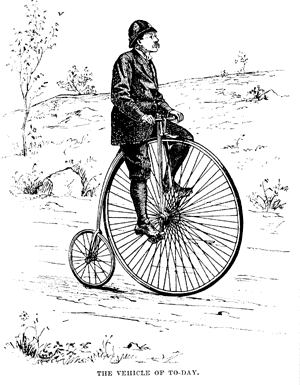The Accomplished Rider

Pratt, 126
In 1879, Charles Pratt noted that the ability to ride the bicycle easily and gracefully on occasion is already an accomplishment which no gentleman can afford to be without (Pratt, 32).
Although Pratt may have been somewhat biased, riding the high-wheeler--or ordinary--was extremely difficult. Perched directly atop a wheel approximately fifty inches high, the rider was always in danger of taking a "header"--being pitched forward up and over the handlebars. Hard rubber tires and rough roads added to the challenge.
Even experienced riders were not immune to falls. An Indianapolis News article, February 7, 1931, with reminiscences about the Indianapolis Zig Zag Cycle Club (1890-1896), states,
woe befell the rider who 'skidded' in a rut . . . . Carl G. Fisher, who afterward gained fame in the motor industry, drew for himself the nickname of Crip (cripple) because he frequently, in bursts of speed, took a spill and ended with many bruises and cuts.
The "safety" bicycle opened the sport to many other people--including women--because it was easier to ride and cheaper to buy. Many riders, however, refused to give up their ordinaries.
Most people learned to ride on their own. During the mid-1890s especially, many manufacturers of bicycles opened riding academies within their shops to encourage people to buy their bicycles. Private academies opened, generally for the rich.
In Indianapolis, for example, Fred I. Willis, a stenographer for the H. T. Hearsey Company, also served as a riding instructor. An Indianapolis News article, November 24, 1961 recounts his memory of teaching Benjamin McKee, the grandson of President Benjamin Harrison.
Bicycle riders in this time freely traveled. Zig Zag Cycle Club members in 1931 reminisced about Sunday trips on ordinaries to "Greenfield, Columbus, Franklin, Shelbyville, Lebanon, Danville, Martinsville and other points within easy riding distance."
Adolph Schmuck, writing in the Indianapolis News, November 13, 1920 remembers a trip with the Indianapolis Bicycle Club around 1890. Twenty-five or thirty members--on both ordinaries and safety bicycles--rode "to Cincinnati, averaging about forty miles a day, so that it took three days . . . . The intervening nights were spent at Rushville and Brookville." Schmuck also notes that wise riders enhance a trip "when it would be much easier and more sensible to skip over a stretch of bad road . . . by taking an interurban car or a train, or possibly a steamboat."
General source: Smith, Social History, 27, 28.
